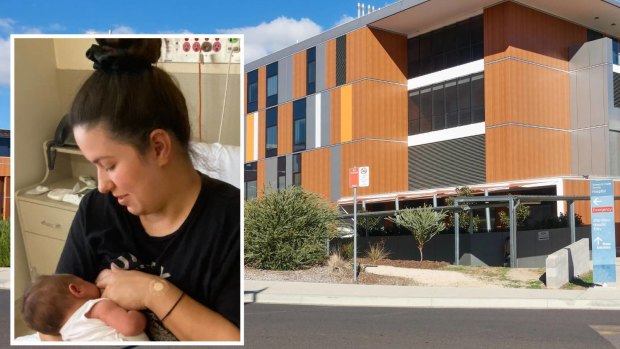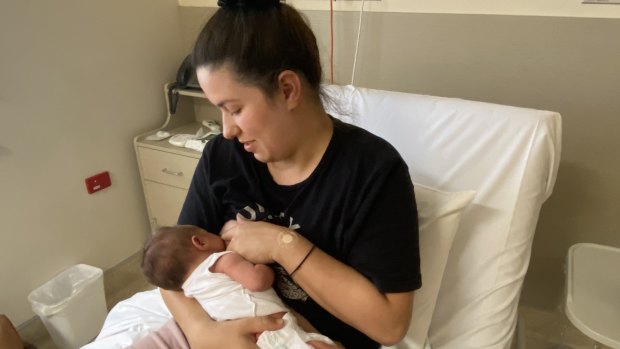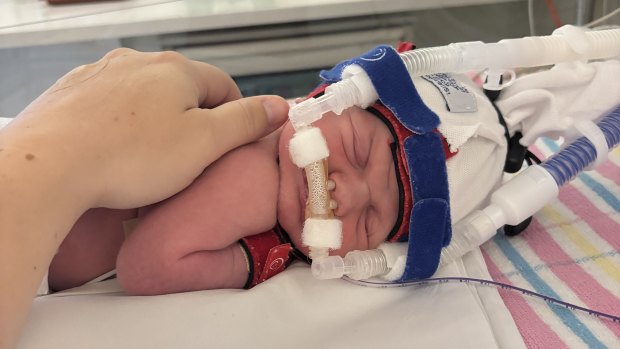- Exclusive
- National
- NSW
- Hospitals in crisis
‘No one had the staff to let me have a baby’: Women forced to drive hours to give birth
A major birthing hospital is repeatedly sending pregnant and labouring women away due to a critical shortage of midwives, forcing some to travel hundreds of kilometres to give birth.
The critical situation at Tamworth Hospital, 400 kilometres north-west of Sydney, could lead to tragedy, doctors and midwives have warned, amid failed recruitment attempts and haemorrhaging of burnt-out staff.

Tamworth Hospital was on bypass when Issie Dewberry went into labour.Credit: Issie Dewberry
Smaller hospitals in its sprawling rural surroundings send pregnant women to Tamworth when they are higher risk, or the hospitals go on “bypass”, diverting patients due to overcrowding or understaffing.
But Tamworth itself spent 14 days on bypass since June, including a four-day stretch this month, sending birthing women – many already diverted from smaller hospitals – to John Hunter Hospital in Newcastle, four hours further from their families and support.
On days Tamworth is not on bypass, it can staff just 12 of its 20 maternity beds.
Obstetrician and Australian Medical Association NSW president Dr Kathryn Austin said the potential for avoidable deaths of a mother and baby was a real concern.
“Tamworth is the hub of that entire region that can offer that higher level of care [including] support for operating theatres, [special care nursery] – all the things you may need during birth. When that goes on bypass, the situation is absolutely dire,” Austin said.
“To get a call that there’s a woman whose baby is in distress 300 kilometres away and not be able to offer services is incredibly distressing,” she said.
Tamworth Hospital was on bypass when Issie Dewberry went into labour in January 2023. Her closest hospital, Narrabri, and Armidale, Gunnedah and Moree hospitals could not admit her.
“No one had the staff to let me have a baby,” Dewberry said. “We were about to be flown to John Hunter Hospital, which sounded extreme, when we were told Inverell Hospital [180 kilometres northeast of Narrabri] had one spot available.”
But Inverell’s one obstetrician was about to go on leave. Dewberry was told she could be induced immediately or have a caesarean in Newcastle.

Issie Dewberry gave birth to her son Matteo at Inverell Hospital via induction because the obstetrician was about to go on leave and no other hospital could take her.
“There was no medical reason to speed up my birth … except that this doctor was going on holiday,” Dewberry said.
Now expecting her second child, Dewberry will move 700 kilometres to live with her parents on the South Coast and give birth at Shoalhaven Hospital rather than risk a repeat of her experience.
Leonie Goldfinch, a midwife and assistant secretary of the Tamworth branch of the NSW Nurses and Midwives Association, said her colleagues had nowhere to turn as they tried to keep the service running with 40 per cent of the staff they should have.
“When Armidale Hospital doesn’t have an obstetrician or anaesthetist, or when Moree, Narrabri and Glen Innes aren’t functioning, all their women come to us,” Goldfinch said.
“We don’t want to send our women away, but we have no choice. When we don’t have the staff, it’s just not safe for women to birth here.”
NSW is facing a national shortfall of midwives, a bitter pay dispute and a chronic regional workforce shortage that Health Minister Ryan Park called the health system’s “single biggest challenge”.
The health district has advertised roles and launched an overseas recruitment drive, which resulted in one new midwife and three nurses for Tamworth’s maternity service.
Park said the state government’s $20,000 bonus for midwives relocating to regional and remote areas would help draw people to Tamworth, but Goldfinch said it was not working, nor was the $10,000 conditional retention bonus.
Queensland offers a $70,000 payment to health workers to take a role in rural or remote locations.
A junior midwife not authorised to speak publicly described working 20-hour days and delivering multiple babies as the most senior midwife on shift.
“I could barely walk ... then I needed to write my notes and drive home trying not to fall asleep,” she said.
“One of these days, it’s either going to kill me, or a patient is going to suffer an adverse event because we’re so tired that we’ll make a medical error.”
Casey Budd had planned to give birth at Moree Hospital until she was diagnosed with cholestasis, a liver condition that can cause complications. Budd was warned Tamworth could be on bypass.

Annabelle was born at John Hunter Hospital in Newcastle after her mother Casey Budd was warned that Tamworth might be on bypass when she was due to give birth.
“I really struggled with the uncertainty,” Budd said. “I was very worried about what would happen if I went into spontaneous labour out here [in Moree].”
She fought to be admitted to John Hunter, a four-hour drive away. Her newborn, Annabelle, spent the first week in the NICU before being flown to Tamworth.
“It was an absolute ghost town,” she said.
The Morning Edition newsletter is our guide to the day’s most important and interesting stories, analysis and insights. Sign up here.